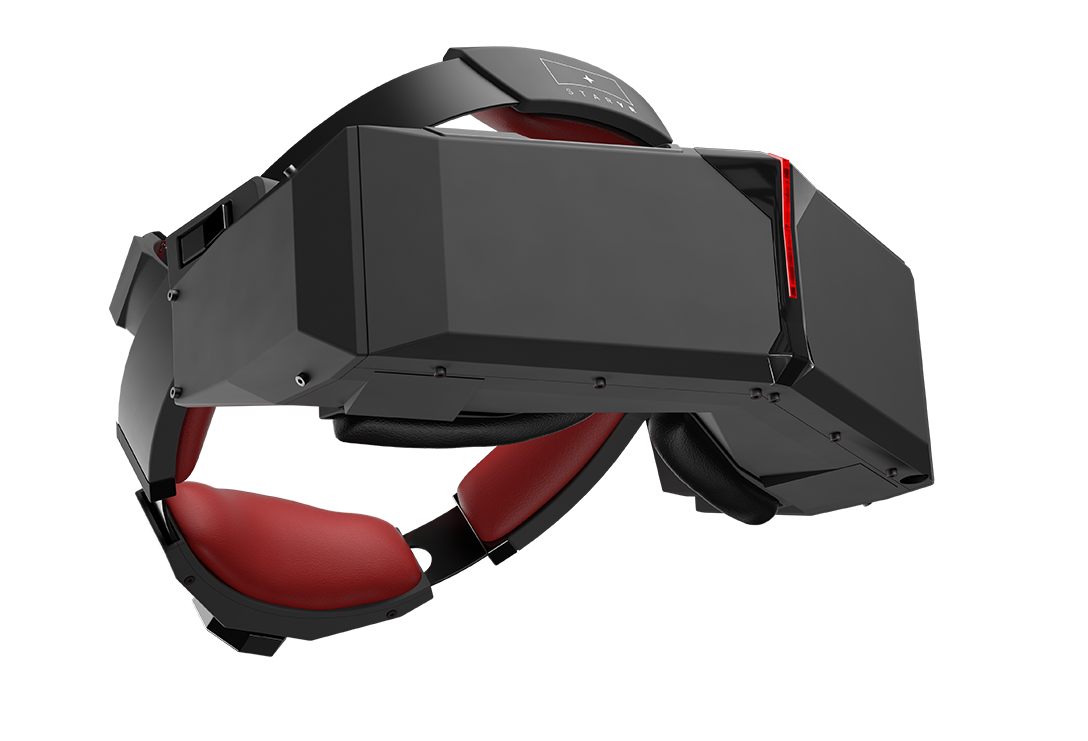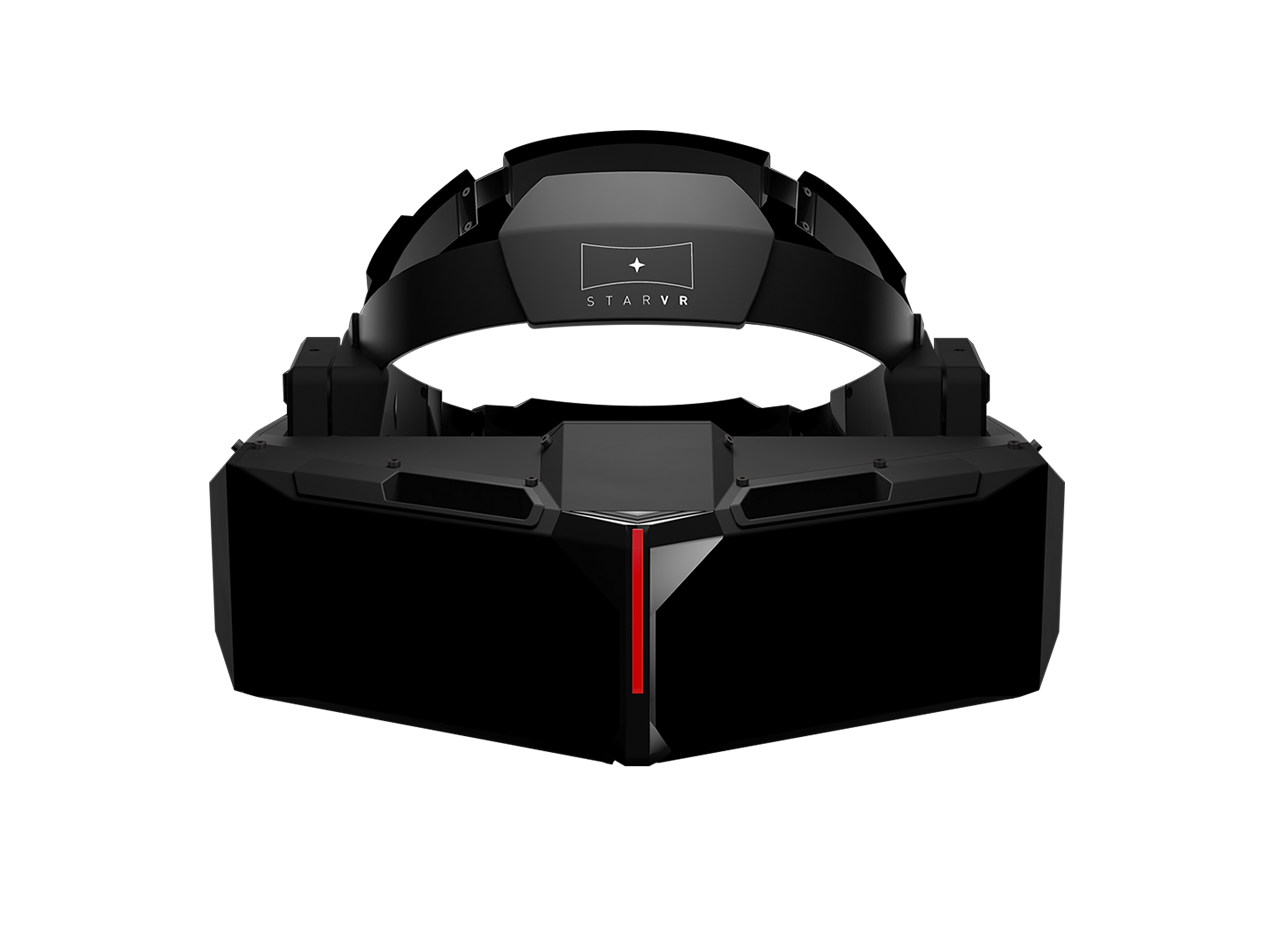Acer In Talks To Design, Manufacture StarVR HMD (Updated)
StarVR just got one step closer to reaching the retail market with Acer and Starbreeze (the studio that brought you Payday 2) signing a letter of intent to form a joint venture to design, manufacture, promote, market and sell the premium VR HMD.
Starbreeze took a spare-no-expense approach to virtual reality, designing the StarVR HMD as a premium device, intended for the best possible VR experience. It features two 2560 x 1440 displays (one for each eye), offering a higher resolution and range of vision than what we currently see in the likes of the HTC Vive and Oculus Rift. Other premium features, such as Tobii's eye-tracking sensor technlogy, are also planned to be integrated into StarVR HMD.
When we had the opportunity to try StarVR for ourselves, we noted that it certainly looked the part, but that the Nvidia GTX Titan X (the top dog in the GPU hierarchy at the time) struggled to churn out the 60 fps that the demo was producing and that it would be a while before graphics processing would catch up to the high-end VR device. However, the impending arrival of the Pascal-based GTX 1080 (which claims to offer twice the performance of Titan X) could enable StarVR to reach that comfortable "no-puke" 90 fps target framerate.
Although the announcement is merely a letter of intent used to form the basis for ongoing discussions regarding a definitive agreement, it's a big step for StarVR, and the manufacturing prowess of Acer could drive the product to a retail release sooner than originally anticipated.
Updated 5/16/16, 9:22am CT: A change was made to clarify Tobii Eye Tracking as a planned feature. It is not currently integrated into the StarVR HMD.
Derek Forrest is an Associate Contributing Writer for Tom’s Hardware and Tom’s IT Pro. Follow Derek Forrest on Twitter. Follow us on Facebook, Google+, RSS, Twitter and YouTube.
Get Tom's Hardware's best news and in-depth reviews, straight to your inbox.
Derek Forrest was a contributing freelance writer for Tom's Hardware. He covered hardware news and reviews, focusing on gaming desktops and laptops.
-
jaber2 I wouldn't buy and HMD without eye tracking, lots of head movement when it should feel naturalReply -
Zapin If the FOV is wide enough and optics are able to give you peripheral focus then I fail to see the point in eye tracking.Reply
The more choices in VR the better imo. Facebook and HTC should not be the only force pushing VR into the mainstream. -
hdmark ReplyI wouldn't buy and HMD without eye tracking, lots of head movement when it should feel natural
agreed! this could be the headset ive been waiting for. may even give me a good reason to upgrade my 970 to a 1080 :D -
Utgardaloki76 In a nut shell eye tracking is all about foveated rendering. Normal rendering has to render all of the image in the highest quality possible even though your eyes only pick up that quality within a very small fraction of the total rendered image. Over 90 percent of the rendering is effectively wasted following the traditional method since the computer has no way of knowing what part you are looking at meaning all has to be rendered at highest fidelity. With foveated rendering how ever the computer only renders what you are looking at using the highest fidelity while the farter away from your focus the quality drops off without you noticing it since your eyes are bad at picking up on quality outside of your eyes’ focus area. The Tobii tech technology is fast enough to track what you are looking at so that you never notice this trick in action. This saves huge amounts of computations at no real fidelity loss to the one using the HMD while at the same time making it feasible to render images at very high resolutions. That’s the idea anyway.Reply -
hdmark Reply17974323 said:In a nut shell eye tracking is all about foveated rendering. Normal rendering has to render all of the image in the highest quality possible even though your eyes only pick up that quality within a very small fraction of the total rendered image. Over 90 percent of the rendering is effectively wasted following the traditional method since the computer has no way of knowing what part you are looking at meaning all has to be rendered at highest fidelity. With foveated rendering how ever the computer only renders what you are looking at using the highest fidelity while the farter away from your focus the quality drops off without you noticing it since your eyes are bad at picking up on quality outside of your eyes’ focus area. The Tobii tech technology is fast enough to track what you are looking at so that you never notice this trick in action. This saves huge amounts of computations at no real fidelity loss to the one using the HMD while at the same time making it feasible to render images at very high resolutions. That’s the idea anyway.
yes from a performance standpoint. but it also gives you eye tracking features lol. so games can start to program knowing this. i forget what game it was, but i remember reading they had it so if you looked away from someone you were talking to, they knew and reacted accordingly
-
utgardaloki Reply17974323 said:In a nut shell eye tracking is all about foveated rendering. Normal rendering has to render all of the image in the highest quality possible even though your eyes only pick up that quality within a very small fraction of the total rendered image. Over 90 percent of the rendering is effectively wasted following the traditional method since the computer has no way of knowing what part you are looking at meaning all has to be rendered at highest fidelity. With foveated rendering how ever the computer only renders what you are looking at using the highest fidelity while the farter away from your focus the quality drops off without you noticing it since your eyes are bad at picking up on quality outside of your eyes’ focus area. The Tobii tech technology is fast enough to track what you are looking at so that you never notice this trick in action. This saves huge amounts of computations at no real fidelity loss to the one using the HMD while at the same time making it feasible to render images at very high resolutions. That’s the idea anyway.
yes from a performance standpoint. but it also gives you eye tracking features lol. so games can start to program knowing this. i forget what game it was, but i remember reading they had it so if you looked away from someone you were talking to, they knew and reacted accordingly
That's another portion of it but the number one feature needed in VR as it is is computational efficiency and foveated rendering helps a ton with that.
But yeah, I shouldn't have said that it is "all about" foveated rendering since eye tracking obviously also helps with the social features of knowing whether someone is looking at you as well as avoiding the dead eye stare.
-
bit_user Reply
Any news about the software stack? Acer had previously embraced OSVR. Is that still the plan?17973183 said:StarVR just got one step closer to reaching the retail market with Acer and Starbreeze signing a letter of intent to form a joint venture
-
Jeff Fx ReplyIf the FOV is wide enough and optics are able to give you peripheral focus then I fail to see the point in eye tracking.
Eye tracking would be useless with the Vive or Rift because of distortion when you look off-center, but if this has clear optics to the edge, people won't turn their heads to look at things, so in menus you'll want the cursor to follow your eyes, rather than your head. -
IndignantSkeptic ReplyIn a nut shell eye tracking is all about foveated rendering. Normal rendering has to render all of the image in the highest quality possible even though your eyes only pick up that quality within a very small fraction of the total rendered image. Over 90 percent of the rendering is effectively wasted following the traditional method since the computer has no way of knowing what part you are looking at meaning all has to be rendered at highest fidelity. With foveated rendering how ever the computer only renders what you are looking at using the highest fidelity while the farter away from your focus the quality drops off without you noticing it since your eyes are bad at picking up on quality outside of your eyes’ focus area. The Tobii tech technology is fast enough to track what you are looking at so that you never notice this trick in action. This saves huge amounts of computations at no real fidelity loss to the one using the HMD while at the same time making it feasible to render images at very high resolutions. That’s the idea anyway.
Thanks, I was going to say that, but also: eye tracking means that other players will know which one of them you are talking to by being able to see who you are looking at.
I hope headsets will track eyebrows also, and generally the face, because facial expressions help with communication a lot more than people seem to realise. -
scolaner Reply
Any news about the software stack? Acer had previously embraced OSVR. Is that still the plan?17973183 said:StarVR just got one step closer to reaching the retail market with Acer and Starbreeze signing a letter of intent to form a joint venture
Acer gave me a statement on that: "Yes, we will still support OSVR, we are working to support all of the major VR standards."

